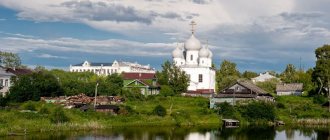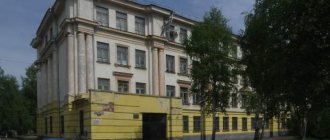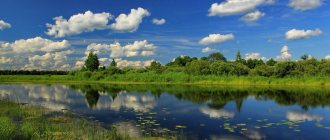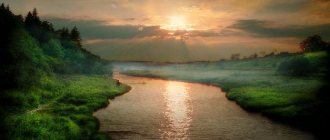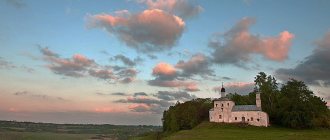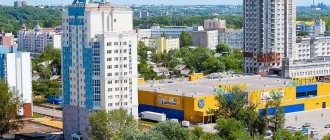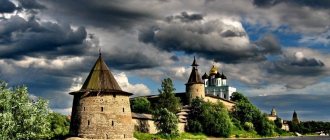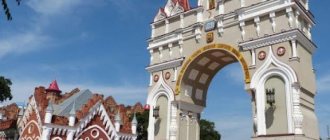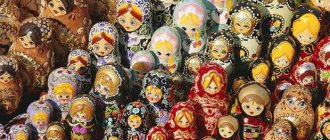Oryol region is considered one of the smallest. It was formed in 1937 and is part of the Central Federal District. Consists of twenty-four municipal districts. The total population for 2022 is 733,682. The regional center is the city of Orel, located in the south, 410 kilometers from Moscow.
Trinity Nativity of the Virgin Mary Optin Monastery, Bolkhov
What holiday is it today?
January 22, 2022, Saturday
Today are holidays, events: Day of Unification of Ukraine Tomorrow: Premiere of the opera “Eugene Onegin” at the Bolshoi Theater
Today is the Orthodox holiday: Martyr Polyeuctus. St. Philip, Metropolitan of Moscow and All Russia, wonderworker... Tomorrow: St. Gregory, Bishop of Nyssa. Venerable Markian the presbyter. Venerable Dometian, Bishop of Melitino. St. Paul of Komel, wonderworker, student of St. Sergius of Radonezh. Saint Theophan, the Recluse of Vyshensky...
Today is a national holiday: St. Philip's Day... Tomorrow: Gregory - Summer Guide...
Seasons
Seasons, four periods of the year (spring, summer, autumn and winter) characterized by certain average temperatures. The period during which the Sun passes through one of these sectors is called the season. Spring in the Northern Hemisphere and autumn in the Southern Hemisphere begin when the Sun passes through the initial circle of declination and its right ascension is 0° (vernal equinox). Summer in the Northern Hemisphere and winter in the Southern Hemisphere occur when the sun's right ascension is 90° (summer solstice). Autumn in the Northern Hemisphere and spring in the Southern Hemisphere begin when the sun's right ascension is 180° (autumnal equinox). The beginning of winter in the Northern Hemisphere and summer in the Southern Hemisphere is considered to be the winter solstice, when the direct ascension of the Sun is 270°... Next: Seasons. Russian folk calendar. Monthly words...
Places for active recreation
The Oryol region is not only about religious shrines and abandoned estates. Athletes are also welcome here and are always welcome. All conditions have been created for active recreation in the region.
Gorki 57
- Coordinates: 53.087247, 36.061860.
The active recreation park, located near Orel, is the only all-season resort in the region. You can ski and snowboard here both in winter and summer thanks to artificial snowmaking. Visitors are offered a choice of 6 trails of varying difficulty with height differences of up to 60 m.
Those who don't like skiing can go tubing. There are 2 descents equipped for them. The park has lighting, so you can ride until late in the evening, and fresh air and a beautiful panorama are a pleasant bonus to your relaxation.
Pronino
- Coordinates: 53.141464, 36.207343.
The Pronino tourist center, located near Orel, will appeal to winter sports enthusiasts. All types of skis, snowboards, sleds, steep slopes and turns. And, of course, a powerful adrenaline rush. The slopes here are prepared not only for experienced skiers.
Beginners who want to try their hand are offered a specially equipped, lightweight track and the accompaniment of an instructor. In addition, Pronino is not only a tourist base. Regional alpine skiing competitions are held here every year.
Zlynsky stud farm
- Coordinates: 53.275266, 35.963898.
The life's work of V.N. Telegin, a great lover of horses, is a stud farm in the village of Zlyn. It was founded in 1872. First in the Kolpnyansky district, but later it was moved to Orlovsky, where it is located to this day.
At first, Telegin bred only Oryol trotters. Then, crossing them with an American standardbred horse, he developed a new breed - the Russian Trotter. Money from the sale of horses and victories in competitions went to the maintenance of the winners themselves and the development of a stud farm.
After the revolution, it was practically destroyed by hungry peasants; only a couple of valuable horses were saved.
In the 20s of the last century, the stud farm opened again, but during the Second World War it was destroyed and plundered by the Nazis. And only five years after the victory, good times came for him. The stud farm was able to survive and maintain its livestock even in the difficult 90s.
Trovants
- Address: s. Andreevka, Kolpnyansky district.
Amazing living stones that reproduce by budding like yeast. They consist of sandstone, but when cut they have age-old rings like a tree. They grow like mushrooms after rain, but have nothing in common with them.
Scientists suggest that this is one of the inorganic life forms because the stones can reproduce, move from place to place and breathe. French scientists, using ultra-sensitive equipment, even managed to calculate the pulse of the Trovantes.
The largest accumulation of living stones in the Oryol region was discovered in the village of Andreevka, Kolpnyansky district. Here they can appear anywhere: on the road, on a plot of land, in a field. Local residents believe that they have healing properties and can cure any disease.
Don't miss the sights of the neighboring regions of Oryol - Bryansk, Kaluga, Tula, Lipetsk and Kursk
The Oryol region is a very hospitable region. Everyone who wants to get acquainted with local attractions is welcome here. And they are definitely waiting for those who have already done this to visit.
Folk calendar about every day
Every day one season always replaces another and this determines a person’s way of life. In connection with this, a folk calendar was formed in which there were practically no nameless, unmarked days. Every day was special, had its own purpose. All this was determined by climate conditions and astrological phenomena.
A calendar is a system for counting periods of time. The first calendars arose a long time ago, in ancient times, because there was a need to measure time. The word calendar comes from the Latin words caleo - to proclaim and calendarium - debt book. This is due to the fact that in Ancient Rome the beginning of each month was especially proclaimed, and because it was customary to pay debts on the first day of the month. Different peoples counted time differently. Some calendars are based on the changing phases of the moon - lunar calendars; in others - the change of seasons - sunny; in others, the length of the year was coordinated with the change of seasons, and the counting of months was associated with the phases of the Moon. Such calendars are called lunisolar.
In Rus', the calendar was called a monthly calendar. Every day, the month book covered the entire year of peasant life, “describing” day by day, month after month, where each day had its own holidays or weekdays, customs and superstitions, traditions and rituals, natural signs and phenomena. The cyclical nature of the calendar is reminiscent of human life, where spring is youth, summer is heyday, autumn is the time of harvesting fruits (it’s good if there are some, otherwise you can live your life without collecting fruits), winter is the time of wisdom and peace. This cyclicality and rhythm determined the way of life of the farmer. The folk calendar was an agricultural calendar, which was reflected in the names of the months, folk signs, rituals and customs. Even the determination of the timing and duration of the seasons is associated with real climatic conditions. Hence the discrepancy between the names of the months in different areas... Next: Folk calendar...
Fishing calendar for every day
The fishing calendar should not be taken as an absolutely indisputable truth. Fish biting is greatly influenced by a whole range of natural factors, as well as the influence on the nature of man himself. You must not forget that the fish’s bite depends and is determined not only by the calendar dates and biological cycles of their life, reflected in the calendar, but also, no less, by the state of their habitat; the bite also depends on weather conditions: air and water temperatures, cloudiness, wind direction and strength, etc... Next: Fishing calendar...
Orthodox calendar about every day
Orthodox calendar: Orthodox, Church and Christian holidays.
The church year is an alternation of weekdays and holidays. On weekdays, a person is called to work “by the sweat of his brow to earn his bread.” Holidays are given in order to feel liberation, to rise above the bustle and routine of the world, to feel involved in the highest of worlds, “where there are no illnesses, sorrows and sighs, but endless life.” Since ancient times, holiday cycles have been associated with the seasons. The pagans associated them with the worship of the forces of nature, the cult of which in the Old Testament was replaced by gratitude to the Creator for the universe. And although the connection between holidays and the seasons has not completely lost its power, since God is present in everything, in the plant and animal world, in human works, it nevertheless faded into the background, giving way to a spiritual foundation built on the Sacred Scriptures. The history of Orthodox holidays dates back to the times of the Old Testament. Each of the Orthodox holidays is dedicated to the remembrance of the most important events in the life of Jesus Christ and the Mother of God, as well as the memory of saints... Next: Orthodox calendar...
Mysterious caves of Oryol region
The underground world has always worried those who live on the surface. That is why caves are always studied especially carefully. Maybe they are where the secrets of all humanity are kept.
Pyatnitsky caves
- Coordinates: 52.951293, 36.089745.
Karst caves on the banks of the Oka already existed when, in the 18th century, Catherine II issued a decree to use them for the production of white stone. Mining stopped only in the 20th century.
During the Second World War, the caves served as a reliable shelter for partisans and local residents from the Nazis. There are 4 caves in total, each of them is about 500 m long. Today they are used to attract tourists.
Mtsensk caves
- Coordinates: 53.299168, 36.580832.
The caves on the banks of the Zushi near Mtsensk have been known for a very long time. Scientists continue to debate about them. Some believe that these are ancient quarries, others insist on natural origin. All caves were given the name Mtsenskaya and a serial number. There are 8 of them in total.
Speleologists explored each of them. The first 6 are similar to each other, consisting of a hall and several dead-end passages. Their depth is about 2 m.
The last cave consists of three halls with low passages between them. From one hall you can go to the surface. Mtsenskaya-7 is the most interesting cave of the group. It is famous for its 10-meter gallery ending in a flat wall.
Russian folk calendar for every day
The word “sign” comes from the word “notice”, i.e. observe. As a result of observing what happens around a person every day, he accumulates life experience. This knowledge was passed down from generation to generation, carefully preserved and people trusted it as a sacred book. Many signs have come to us from the depths of centuries without losing their knowledge. Each of us is free to choose: to dismiss all this as an absurd superstition or to take a closer look at the signs and take the centuries-old experience of generations more seriously. Most of us, when taking exams, ask them to scold them, boasting about some kind of good fortune or luck, spit so as not to jinx them or knock on wood, take a detour if a black cat crossed the road, are afraid of the number 13 and much more. And who among us does not have lucky things, numbers? Who has never resorted to the help of fate at least once in their life, who has not believed in secrets? It’s as if everything connected with signs is hidden somewhere deep in our subconscious. Often we remember them mechanically, unconsciously, or just as a joke. But, undoubtedly, the signs contain a lot of accurate knowledge and practical wisdom of our ancestors. They cover all the characteristic, often difficult to perceive, natural phenomena. Signs have preserved a lot of what was in old folk holidays and customs; they help predict the weather, grow crops... Next: Folk signs...
Resources and territory
Geographical position. Territory. Climate
The Oryol region is located in the very heart of Central Russia, in the south of the Central Economic Region. Its neighbors are: from the west - Bryansk region, from the north - Tula and Kaluga regions, from the east - Lipetsk region, from the south - Kursk regions. Orel, which is located almost in the center of the region, lies 382 km south of Moscow, 398 km from Kharkov, 141 km from Bryansk, 426 km from Voronezh, 387 km from Smolensk, 1034 km from St. Petersburg, 944 km from Brest, 1009 km from Riga. The area of the Oryol region is 24.7 thousand square meters. km (67th place in Russia).
The Oryol region is located in the central part of the Central Russian Upland, within the steppe and forest-steppe zones. The climate is moderate continental.
The average temperature in January is minus 9 degrees. November, December and January are the cloudiest months. The average number of days with snow cover is 126. The average temperature of the warmest month, July, is plus 18–20 degrees.
There is a moderate amount of precipitation per year - from 490 to 590 mm, with twice as much in summer as in winter, and more in autumn than in spring. The amount of precipitation is sufficient for normal growth and development of agricultural crops.
The surface relief is raised and hilly. The main part of the occupied area is agricultural land (2051.2 thousand hectares), of which 1570.1 thousand hectares (76.5%) is arable land.
There are various types of soils in the region - from light gray forest soils in the west to leached and typical black soils in the east and southeast. In total, leached and podzolized chernozems make up about 43 percent of the total area, dark gray forest soils - 24% of the land, the rest belong to gray forest, soddy-podzolic and light gray forest soils. And in total there are more than 240 soil varieties on arable land in the region.
The ruggedness of the relief, the nature of the soil cover and economic activity determined the widespread active development of water erosion processes. More than half of the arable land belongs to the category of washed away and erosion-hazardous lands; almost the same amount needs liming.
Water resources
In the region there are more than 2 thousand rivers and streams with a total length of 9100 km.
The longest and most abundant rivers in the region are the Oka, the source of which is in the south of the region (length within the region - 190 km, average annual flow on the border with the Tula region - 2058 million cubic meters), Zusha (tributary of the Oka, average annual flow - 988, 6 million cubic meters), Sosna (tributary of the Don, average annual flow on the border with the Lipetsk region is 687.0 million cubic meters). Zusha, Sosna, and a number of other smaller rivers have rather fast flows due to the significant difference in elevation. Until the 60s, the energy of water from the rivers of the Oryol region was actively used for energy generation (small hydroelectric power stations, water mills).
The main reservoirs of the Oryol region: Neruchanskoye in the Sverdlovsk region (6.8 million cubic meters), Lubna feeding pond in the Khotynetsky region (4.5 million cubic meters), Oryol reservoir (4.0 million cubic meters). There are 18 reservoirs in the region with a capacity of 1 to 10 million cubic meters. each and about 140 ponds with a capacity of up to 1.0 million cubic meters. each mainly operate on the principle of seasonal passive flow regulation, accumulating approximately 135.0 million cubic meters. m of surface moisture, which is about 3.84% of the annual runoff and only about 5.91% of the total runoff for the year with a minimum water content of 95% of the supply, are used for fish farming, irrigation and recreational purposes.
The total surface area of all reservoirs in the region is more than 4,700 hectares.
The Oryol region has significant groundwater resources, on which domestic, drinking and partly industrial water supply is based.
Surface water is used by enterprises exclusively for production needs. In general, the Oryol region belongs to the category of reliably supplied with drinking water.
Forest fund. Ecology. Minerals
According to the nature of the vegetation cover, the territory of the region belongs to the forest-steppe zone. Forests occupy 207.2 thousand hectares, or 8.4% of the region's territory.
Forests are located mainly in small tracts, the largest forest tracts are located in the west and north-west of the region (in Khotynetsky, Znamensky, Dmitrovsky, Mtsensky, Shablykinsky districts), where deciduous and mixed forests occupy a predominant position: more often - oak, birch, pine, aspen , spruce; less often - maple, linden, alder, larch, rowan. There are eight mechanized forestry enterprises.
The total volume of forest reserves is 25.9 million cubic meters. m, of which: - by species groups: - coniferous 6.35 million cubic meters. m - hardwood 8.29 million cubic meters. m - soft-leaved 11.27 million cubic meters. m - by age group: - young animals 2.8 million cubic meters. m - average age 21.1 million cubic meters. m - ripening 3.4 million cubic meters. m - ripe and overripe 2.0 million cubic meters. m All forests in the region belong to the 1st group and mainly perform water protection, sanitary and hygienic, recreational and other protective functions; about 35.5 thousand hectares of forest plantations are allocated to specially protected natural areas. The volume of logging is small: the harvested wood is intended mainly for intraregional consumption (firewood, lumber). The area of intermediate felling in 2015 was about 0.5 thousand hectares, which made it possible to obtain 25.3 thousand m3 of wood. Including the volume of liquid wood obtained through intermediate thinnings amounted to 24.4 thousand m3, of which 5.2 thousand m3 was commercial wood. Reforestation in the region is carried out mainly on the lands of the State Forest Fund on an area of up to 400 hectares per year.
In general, the environmental situation in the Oryol region is characterized by relative stability. This is due to the absence of industrial giants and large-scale mineral development in the region. However, the pollution of water bodies by industrial enterprises and the state of atmospheric air in large cities are causing concern.
The Oryol region is located on the border of three natural zones - taiga, deciduous forests and forest-steppe. This leaves an imprint on the richness of its landscapes and the diversity of living species. The region is home to 70 species of mammals, 256 species of birds, 7 species of reptiles, 12 species of amphibians, 38 species of fish and 1 species of cyclostomes. Of the mammals, 30 species are classified as rare, of which 4 species are included in the Red Book of Russia (2000) and 16 species are included in the Red Book of the Oryol Region (2007).
The conservation of biological diversity in the forest-steppe zone of European Russia in modern conditions is a complex task. This is due, first of all, to the fact that it was the forest-steppe that underwent the greatest economic development. Almost all natural ecosystems are subject to negative anthropogenic impacts.
In this regard, territories that contribute to the conservation of rare and unique natural objects acquire special value. The region maintains a state cadastre of specially protected natural areas (SPNA) according to uniform rules for the Russian Federation, using unified forms of information storage and observing the principles of compatibility and comparability with state cadastres of natural resources. The network of specially protected natural sites in the region covers the main types of biocenoses, as well as individual valuable objects.
The Oryol Polesie National Park is located in the central part of the Central Russian Upland, in the river basin. Fuck off. The area of the reserve is 77.7 thousand hectares. The forests of the Park are the largest forest area in the region. Pine and mixed forests predominate. The flora of Oryol Polesie is extremely diverse. Currently, the Park's flora includes 925 species of vascular plants, of which more than a quarter of the species are rare.
In Oryol Polesie, 272 species of vertebrates have been recorded, including 50 species of mammals, 177 species of birds (of which 136 are nesting species), 7 species of reptiles, 12 species of amphibians and 26 species of fish.
The Oryol region has reserves of iron ore, building materials (limestone, sand, clay, etc.), hard and brown coal, peat, and phosphorites. Extraction of limestone, chalk, crushed stone, gravel, construction sand, and clay is carried out. A rich Novoyaltinskoe iron ore deposit (the tongue of the Kursk magnetic anomaly) with an iron content of 56-60% and occurrence at a depth of 182-260 m has been discovered in the region. The deposit is of industrial importance, but is currently not being developed.
Population
The population of the Oryol region is 759.7 thousand people. On the territory of the region, 7 cities, 24 municipal districts and 13 urban-type settlements from 3 to 12 thousand inhabitants were formed.
The administrative center is the city of Orel (319.7 thousand inhabitants, founded in 1566), two significant largest cities: Livny with a population of 47.9 thousand people and Mtsensk with a population of 38.7 thousand people.
The number of rural administrations is 223, rural settlements are 3054, mostly small and medium-sized settlements (average number of inhabitants is 106 people). Large rural settlements (with more than 1,000 inhabitants) are concentrated mainly around Orel.
Transport
Despite the lack of river and sea navigation and, accordingly, ports, the Oryol region has a fairly developed transport infrastructure, the profitability of which is determined, first of all, by its relative proximity to the capital of Russia - Moscow. Thus, the most important transport routes of federal importance pass through the region and directly through the regional center - the city of Orel:
| Types of highways | Directions relative to area | Name of highways |
| Railway | From North to South | Moscow-Kharkov-Crimea-Caucasus |
| From west to east | Riga-Voronezh-Saratov | |
| Automotive | From North to South | Moscow-Orel-Kharkov-Simferopol |
| From north to southwest | Moscow-Kyiv | |
| To the East | Orel-Tambov | |
| To the west | Orel-Bryansk |
The length of public railway tracks is more than 590 km; paved roads - about 9,200 km, i.e. to almost every populated area. The region's major railway junctions are the following stations: Orel, Livny, Mtsensk, Verkhovye, Luzhki (in the south-eastern part of Orel).
In addition, 1 oil and 3 international gas pipelines, which are of great strategic importance, pass through the region.
The total freight turnover of transport is 8.9 billion ton-km, with rail transport accounting for 6.6 billion ton-km and road transport 2.3 billion ton-km.
Holiday calendar, dates and events of the year
All state and professional holidays in Russia, including significant World and International holidays, and other equally interesting holidays and events about every day.
The holiday has always kept pace with the history of mankind. Social time can be divided into three types: everyday life (weekdays), weekends and holidays. Everyday life is a series of practices repeated day after day and every day (work). Weekends are regular breaks from the rush of everyday life. It is believed that on weekends a person should restore his strength after working days. Day off, non-working day. A holiday is a day of celebration established in honor or in memory of someone or something. A day or series of days celebrated by the church in memory of a religious event or saint... Next: Calendar...
Prayer book, Orthodox prayers for every day
Prayer is the most powerful means for healing all illnesses - both physical and mental. Prayers can be laudatory or grateful, petitionary and repentant. If we have offended God, sinned, we must ask Him for forgiveness, that is, repent. Such prayers are called repentant prayers. If everything is fine with us, if we and our loved ones are healthy and prosperous, if we have a place to live, something to wear, something to eat, we must glorify and thank God for this. Such prayers are called praise or thanksgiving. If some misfortune, illness, trouble or need happens, you need to ask God for help. Such prayers are called petitionary... Next: Orthodox prayers...
Oryol district
It is one of the administrative-territorial units of the Oryol region. The center is Orel, which, at the same time, is not part of the district.
The Oryol district is located in the central part of the region of the same name, surrounding the city of Oryol on all sides. Its area is 1701.4 km2. It was formed on July 30, 1928. For some time it was part of the Kursk region.
The area's population grew rapidly until 1970, and then growth was very slow. In recent years, the population has been declining slightly. The share of the urban population is 16.5%. In total, the district includes 17 municipalities (1 urban and 16 rural).
Agriculture is in great decline. In the future, it is planned to build a waste recycling plant. Basically, the population living in the region studies and works in the capital of the region.
The villages of the Oryol district of the Oryol region are 4 settlements:
- village of Zilina;
- Polozovsky Dvors;
- Stanovoe village;
- Nizhnyaya Kalinovka.
The remaining settlements in this category are divided into villages and towns: 8 villages and 4 towns.
Zodiac, astrological, eastern calendar. Zodiac signs
In ancient times, to establish the calendar, priests used knowledge of the positions of all the planets. Before the reform of Peter 1, the New Year was celebrated on the Day of the Autumn Equinox. On this day, according to ancient legend, the most peaceful treaty was concluded between the Great Race (ancient Slavs) and the Great Dragon (ancient Chinese) and it was approximately 7518 years ago... For the ancient Slavs, the calendar month corresponded to the lunar cycle from new moon to new moon, taking into account such Thus, the relationship of the entire annual cycle with astronomical and natural phenomena. There was no coherent calendar system. The main natural phenomena are still considered to this day to be the days of the solar equinox and solstice - the Slavic holidays Maslenitsa, Kupala, Ovsen and Kolyada. But during the time of Peter 1, all ancient Slavic calendars were abolished and a new Western European calendar from the Nativity of Christ (Julian calendar) was introduced, while the beginning of the calendar was moved to January 1. The Julian calendar (old style) did not take leap days into account and accumulated one extra day every 128 years. After the October Revolution in 1918, the Gregorian calendar (new style) was introduced in Russia, according to which an amendment of 13 days was introduced. The calendar of the ancient Slavs was based on two planets: the Sun and the Moon. And now they don’t use anything at all. The calendar has become static. There is no such thing as the calendar, it turns out, resting on some planet. Nobody even knows about it. There are just some standard numbers, there are months and holidays. The calendar is based on the Sun and Moon. Why is this so? Because these two luminaries influence the Earth. The Earth revolves around the Sun, and the Moon revolves around the Earth. And these two luminaries create the atmosphere on the planet. From here the calendar is built... Next: Astrological calendar...
Cities of the Oryol region
Orel (318,136 thousand people) is the administrative center of the region. It was founded by Ivan the Terrible in 1566 at the confluence of the Oka and Orlik rivers as a fortress to protect the southern borders of the Russian kingdom. Today, 60% of the region's industrial potential is concentrated here.
The largest Coca-Cola plant in Russia is located here, supplying the southern half of the Central Federal District with its products. There are problems in the city, but they are not very different from the problems of large cities in neighboring regions. This is the environment, street crime, the decline of the population’s culture. Although Orel can still be called a fairly decent city, if we talk about the level of culture.
Livny is the second largest city in the region, population - 49,342 people. It was founded in 1586, although the first mention of a settlement in this place dates back to the 12th century. Unfortunately, it was completely destroyed during the Mongol invasion. Now there are several large enterprises in the city that produce equipment, pumps, filters, and building materials. One of the city's attractions is a preserved factory building from the 19th century. And also near Livny there is the village of Pleshkovo, famous for its pottery.
Adam's Mill is the same 19th century factory in Livny. Photo by Julia-Andreeva-1981 (https://fotki.yandex.ru/users/julia-andreeva-1981/)
Mtsensk (population: 40,704 people) is an ancient Russian city, mentioned back in 1146. The city is famous for its folk craft - Mtsensk lace. Today it is a large industrial city. There are metallurgical enterprises where they produce cast iron and non-ferrous metals. It is also home to one of the largest distilleries. There are many historical monuments in Mtsensk, including two churches from the 17th century. Among the disadvantages of the city, it should be noted the difficult state of the environment caused by the activities of metallurgical enterprises.
Dream books online, interpretation of dreams
A dream book is nothing more than an interpreter of dreams and dreams, a translator of dreams. Since ancient times, people have been using dream books; dreams have always been given great importance, and people have often noticed the prophetic properties of some dreams. The dream book can become your faithful assistant every day and throughout your life, thanks to the dream interpreter you can always make the right decisions, the dream book will help you resist temptations in time, and will warn you against wrong steps and frivolous actions. Further…

